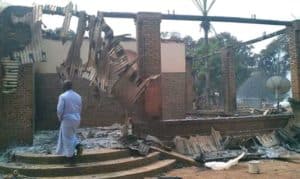Central African Republic: diocese comes back to life in wake of massacre
THE NUMBER OF PEOPLE who have died as a result of the Nov. 15, 2018 terrorist attacks on the Cathedral of the Sacred Heart in the Diocese of Alindao, Central African Republic, and on the refugee camp right next to it, continues to rise. The number of dead has no reached 80, including two priests and a Protestant pastor. The local Church published a report to analyze the details of the tragedy, which marked an upsurge of violence targeting Christians in the south of the country.

“The people, who almost all fled into the forest, are now returning, hoping to be able to find a few grains of rice that they can eat and foraging among the ashes for any beans that have been only partially burned.” These are the word of Bishop Cyr-Nestor Yapaupa of Alindao.
The refugee camp, which once sheltered more than 26,000 people and was supervised by the priests of the diocese, has now been totally destroyed. “The elderly and the handicapped were simply burned alive—if they were not already shot dead or beheaded,” said the bishop.
He continued: “In their panic, many parents were forced to leave one or other of their children behind in order to save the others. The attackers simply fired indiscriminately on the people. Fire tore through the reception center and several of the church buildings. The cathedral lost its roof. The terrorists stole cars, motorcycles, and solar panels, food from the storeroom, money and fuel.”
There are more than 14 different armed groups scattered across the Central African Republic. The president of the country, Faustin Touadéra, does not have the resources to control the activities of these groups. They are the remnants of the civil war that started in 2013, and which dissolved into clashes between the Seleka rebels—an almost entirely Muslim coalition—and the so-called “anti-balaka,” initially a self-defense militia, which ultimately degenerated into gangs of animist and nominally ‘Christian’ youths.
A Muslim militia, an offshoot of the Seleka, was behind the November 2019 attack. The group is ironically named “Unity and Peace in Central Africa” (UPC). The UPC considered the assault a legitimate defensive measure, as anti-balaka militants had killed two Muslims in Alindao.
However, Church sources charged that the massacre was the UPC’s way to enrich its depleted coffers, with Alindao “a flourishing commercial center, and a cow to be milked.” Earlier last fall, the UPC was lost control of gold and diamond mines that provided the group’s funding. Local traders had begun protesting against being extorted by the UPC; the group was desperate for an alternative source of income.
“Organized and structured as she is, the Catholic Church plays a fundamental role in responding to the local humanitarian crisis,” Bishop Yapaupa explained. The Church maintains relations with the humanitarian agencies, with the president and the UN military mission, MINUSCA, in the country. At the same time, however, said the bishop, the Church is an “object of covetousness,” and an institution that militants would like to bring down.
A source reported that “two days before the tragedy, the leader of the UPC was received by the Mauritanian UN contingent.” The diocese considers this meeting as having been possibly one of “consensual planning” or outright collusion—the Mauritanian troops failed to intervene during the attack. The leaders of the three main faith communities in the Central African Republic – Cardinal Dieudonné Nzapalainga of Bangui, Protestant Pastor Guerekoyame Gbangou and Imam Omar Kobine Layama—have called for an investigation by the international community.
“We have lost everything, except our faith,” Bishop Yapaupa said. He added: “We can still look into the eyes of our enemy and offer him our sincere pardon, without giving way to a spirit of vengeance or fear.”
Aid to the Church in Need is providing emergency funds to help the Catholic community, as well as Mass stipends to support the local clergy in this situation of total desolation.
—Emmanuelle Kaeser

